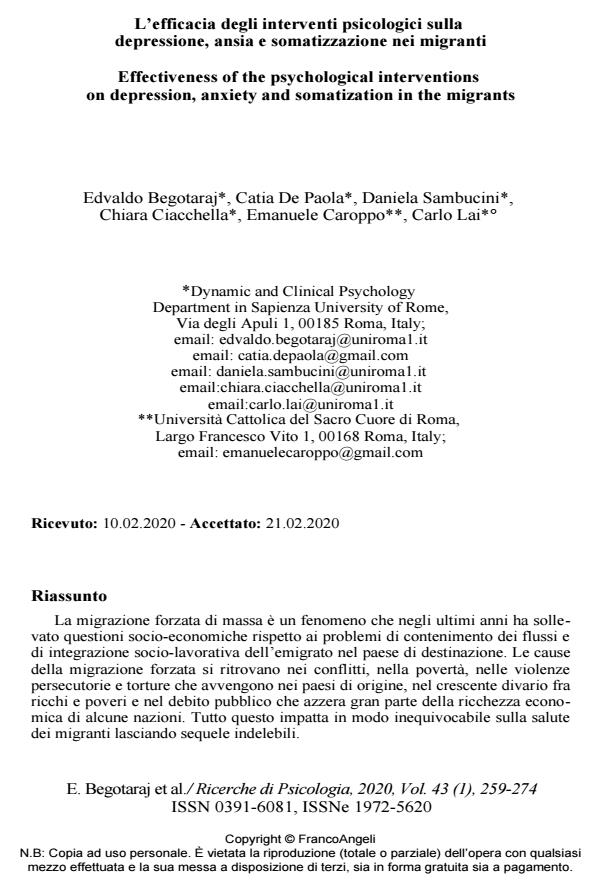Effectiveness of the psychological interventions on depression, anxiety and somatization in the migrants
Journal title RICERCHE DI PSICOLOGIA
Author/s Edvaldo Begotaraj, Catia De Paola, Daniela Sambucini, Chiara Ciacchella, Emanuele Caroppo, Carlo Lai
Publishing Year 2020 Issue 2020/1
Language Italian Pages 16 P. 259-274 File size 220 KB
DOI 10.3280/RIP2020-001012
DOI is like a bar code for intellectual property: to have more infomation
click here
Below, you can see the article first page
If you want to buy this article in PDF format, you can do it, following the instructions to buy download credits

FrancoAngeli is member of Publishers International Linking Association, Inc (PILA), a not-for-profit association which run the CrossRef service enabling links to and from online scholarly content.
The massive forced migration is a phenomenon that has raised socio-economic questions in the last years respect to the problems of the flowes containment and social and employment integration of the emigrants in the countries destination. The causes of the forced migration are originated from the poverty, war conflicts, tortures, persecutions different types of violence happening at the country of provenience, growing up between rich and poor and in the public debts which wipes the economic wealth of some nations. This aspects impact on migrants health leave indelible sequelae. In the last years, indeed, the scientific landscape has extended the focus of interest on psychological aspect of the migrant. The traumatic experiences suffered by the migrants can be observed in 3 moments: before, during and after the migration traveling. These experiences cause typical and distinctive psychological sequelae, same as depression, anxiety and somatization as the much more relevant symptomology. Therefore, the necessity to promote the psychological wellness of the migrants in the host country arises in the recent years. The aim of the review was to assessed the efficacy of the main psychological treatments applied to the migrants through a thoroughly and qualitative analyses of the literature. The preliminary collection of data was focused on studies that provided psychological interventions with a pre-treatment and post-treatment assessment at least of the depression, anxiety and somatization. The selection included studies of the three kinds: randomized-controlled design, almost experimental, observative. The review was conducted including 52 studies. The psychological interventions have been classified in 5 categories of treatment (cognitive-behavioural therapy, narrative exposure therapy, dynamic therapy, combined psychological treatments, psychological treatments combined with pharmacological treatments). There were calculated the significative and non-significative results for each category of treatment referring to each outcome: depression, anxiety and somatization. The qualitative results of the review showed that the cognitive-behavioural therapy had a significative effect on the depression at 61% of the cases, on anxiety at 50% of the cases, and had no effects on the somatization. The narrative exposure therapy had significative effects on the depression at 57% of the cases), it had effects on somatization at 50% of the cases and had no effects on anxiety. The dynamic therapy had significative effects on the depression at 50% of the cases, on the anxiety at 50% of the cases, and the same size effect on somatization at 50%. The combined psychological treatments had a significative effect over the depression at 46% of cases and had a significative effect over the anxiety and somatization, both at 60% of cases. The psychological treatments combined with pharmacological treatments had a significative effect over the depression at 61% of cases, over the anxiety at 36% of cases and over the somatization at 39% of cases. Therefore, the qualitative observation showed the probability to have a significative effect post-treatment over the anxiety lower than 50% comparing to somatization. Specifically, concerning the individual treatments, the effects of the cognitive-behavioural therapy on the anxiety seemed to be due to the fortuity. At the same time, it seemed to influence the somatization, indeed the effect is verified on the depression. Regarding the narrative exposure therapy, the probability to verify a significative effect on the depression is caused by the fortuity, same as for the dynamic therapy and for the combined psychological treatments. Also, it seemed to cause no effect on depression and anxiety. Lastly, concerning the psychological treatments combined with pharmacological treatments, there were find significative effects of efficacy on the depression, but no effects on anxiety and somatization.
Keywords: Migration, psychological interventions, depression, anxiety, somatization.
- Migrazioni e psicologie. Introduzione al Forum Alessandro Antonietti, Antonella Marchetti, in RICERCHE DI PSICOLOGIA 1/2020 pp.13
DOI: 10.3280/RIP2020-001002
Edvaldo Begotaraj, Catia De Paola, Daniela Sambucini, Chiara Ciacchella, Emanuele Caroppo, Carlo Lai, L’efficacia degli interventi psicologici sulla depressione, ansia e somatizzazione nei migranti in "RICERCHE DI PSICOLOGIA " 1/2020, pp 259-274, DOI: 10.3280/RIP2020-001012